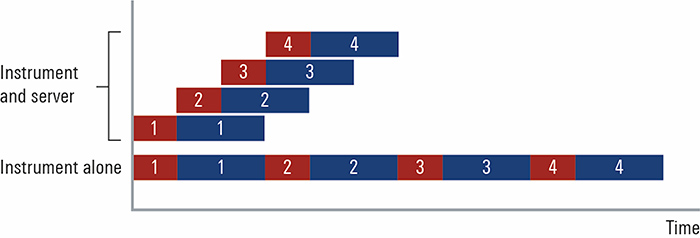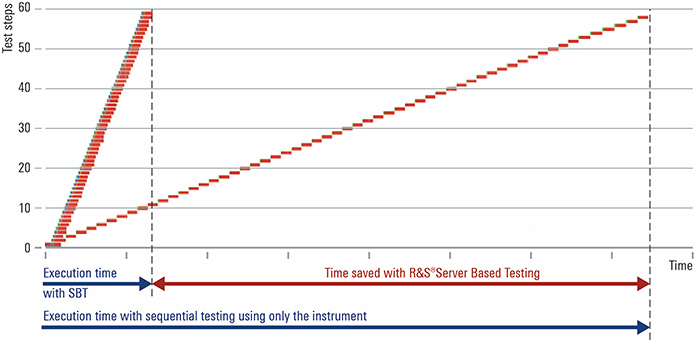Turbocharging testing of base stations
Rohde & Schwarz take a closer look at server-based measurement data evaluation for fast production test – well suited for manufacturers of demanding products such as mobile network base stations.
Compliance with the tightly toleranced specifications of advanced RF products, such as mobile network base stations, is only possible with random-sample measurement and calibration of devices in production. Experience shows that the level of complexity in testing rises with each new generation.
With 5G, the test effort is driven not only by the additional frequency ranges, broader frequency bands and number of antenna paths to be calibrated due to massive MIMO, but also by the higher installation density of the base stations. To meet ambitious coverage specifications, more locations than ever must be equipped and a corresponding number of base stations must be produced. Manufacturers therefore welcome every possible way to shorten cycle times on the production line.
RF parameters are generally measured by signal and spectrum analysers. The working speed of these instruments has increased over the years, in line with progress in information technology. Rising test effort, particularly in production, has negated this performance gain, resulting in new demand for shorter test times. Restructuring the test process offers an opportunity to meet this need without having to use ever-faster instruments.
Divide and conquer
Signal analysis can be roughly divided into two phases: acquisition and evaluation. In signal acquisition, the baseband information is obtained from the RF frequency range of interest and passed on to the analysis section in the form of I/Q data written to memory. Evaluation of signal metrics by analysis of the I/Q data is a computation process and therefore does not require an instrument. Signal and spectrum analysers perform both tasks because they usually serve as universal T&M instruments in the lab, with measurement results shown directly on the screen. Here ‘directly’ can be taken literally because the measurement speed of advanced instruments is so high that even demanding analyses can run in nearly real-time and parameter changes take at most a few seconds to result in a new display.

Above: Figure 1. The two measurement steps – data capture (red) and data analysis (blue) – usually run sequentially in the signal analyser. New data capture is paused during the analysis phase, as otherwise the buffer would quickly overflow
In mass production, however, every second counts – especially when the overall measurement process consists of a sequence of many individual measurements whose times add up, as with base station tests. The decisive consideration for boosting efficiency is that calculating measurement results always takes significantly longer than capturing measurement data. Data capture pauses during analysis, so the costly instrument is not used to full capacity. To eliminate the evaluation bottleneck, it makes sense to assign data capture and data processing to two separate entities (Figure 1).
Server-based testing
This is exactly what R&S Server Based Testing (SBT) from Rohde & Schwarz does. It is specifically aimed at manufacturers of 5G base stations and RF components that need higher test throughput, and it considerably improves the speed of repetitive automated tests.
Figure 2 shows the timeline of a test sequence composed of 59 test steps, as it typically occurs in the characterisation of 5G NR power amplifiers. Each step consists of multiple subtasks: preparation, data capture, data transmission and error vector magnitude calculation. To allow the instrument, for example an R&S FSVA3000 signal and spectrum analyser, to be operated at maximum acquisition speed without creating a data backlog, the server should process 16 analysis tasks in parallel. This reduces the test execution time by a factor of 5.5 compared with sequential operation. Depending on the concrete testing scenario, a further increase in overall speed performance is possible.
Implementation
SBT is a Linux-based modular software platform that can be scaled according to the required degree of parallelisation and the processing power of the computer hardware. The degree of parallelisation can be defined at run-time. Computation is performed by SBT microservices, which effectively represent the granular processing units of the platform. Server hardware architectures that can process hundreds of measurement tasks simultaneously are available at reasonable prices. This allows the data streams of multiple I/Q sources or test stations to be handled in parallel.
Fast data transmission between the instrument and the server takes place via Ethernet. The R&S FSVA3000 can be equipped with a 10Gbit/s LAN interface for this task. Other instruments can also be used as data sources. The choice depends on the required RF performance and test throughput.

Above: Figure 2. This EVM measurement of a base station power amplifier, consisting of 59 test steps, can be accelerated by a factor of 5.5 by relocating the calculations to a server
R&S Server Based Testing currently consists of components required for typical scenarios in the production of 5G and LTE/4G base stations in line with 3GPP standards. Along with standard compliant analysis of modulation quality (error vector magnitude, EVM) in uplink and downlink channels, SBT can also efficiently calculate spectral parameters such as ACLR and SEM. Other metrics can be implemented quickly and cost-effectively as needed.
Integration of R&S Server Based Testing into existing test ecosystems is remarkably easy: job tickets containing specific measurement instructions can be passed through a REST-compliant interface. Asynchronous parallel processing enables optimal utilisation of the available hardware platform. Measurement results are sent back to the test executioner over the same interface.
Summary
Instrument performance is increasing perceptibly with every generation. Unfortunately, this is also true for the requirements of new technologies, which often negate these gains. Advanced digitalisation of T&M equipment makes it possible to accelerate performance hungry testing by parallelisation. This consists of fragmenting the analysis of measurement data in I/Q format and handing it over to a server that can be scaled in line with requirements. This allows the high signal acquisition rate of advanced RF instruments to be fully utilised. For manufacturers of demanding products such as mobile network base stations, this is especially beneficial. With relatively modest investments in their server landscape, they can dramatically increase test throughput on the production line without having to procure more instruments.
Dividing data capture and data analysis between different technical entities is clearly the way ahead for production test equipment, but it also offers benefits for development engineers. For example, the R&S Cloud4Testing SaaS enables time-offset measurement data evaluation over the internet.










